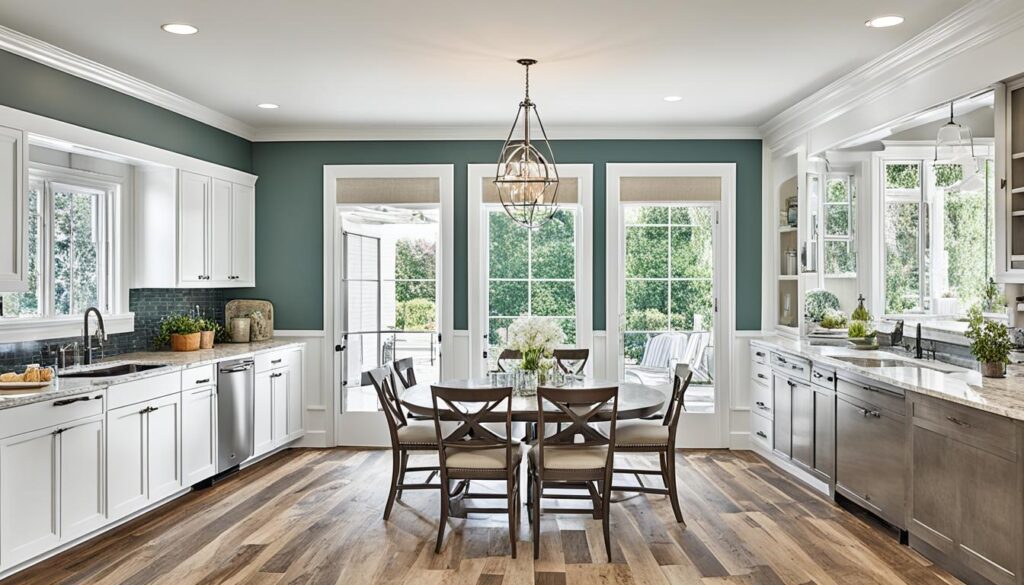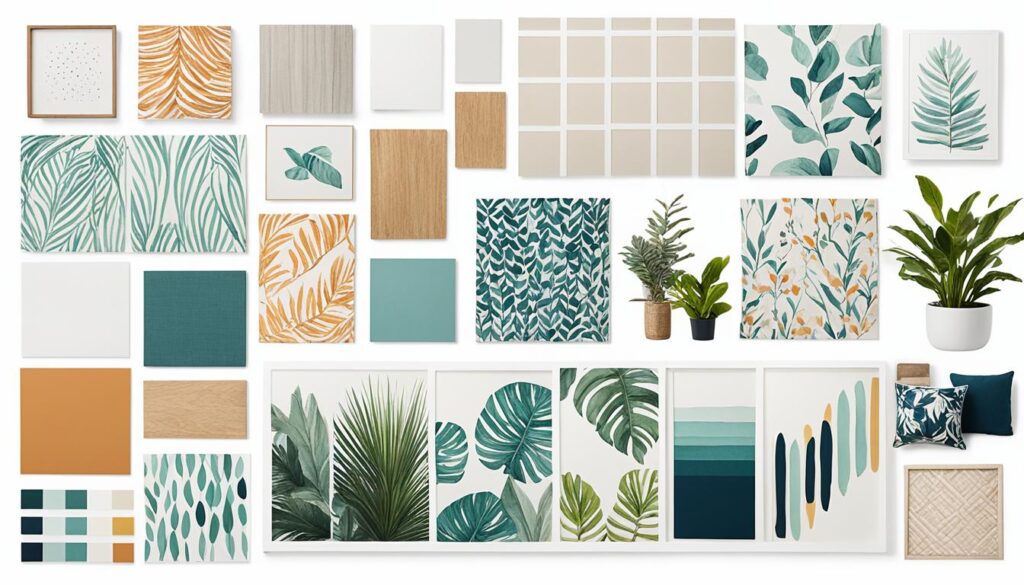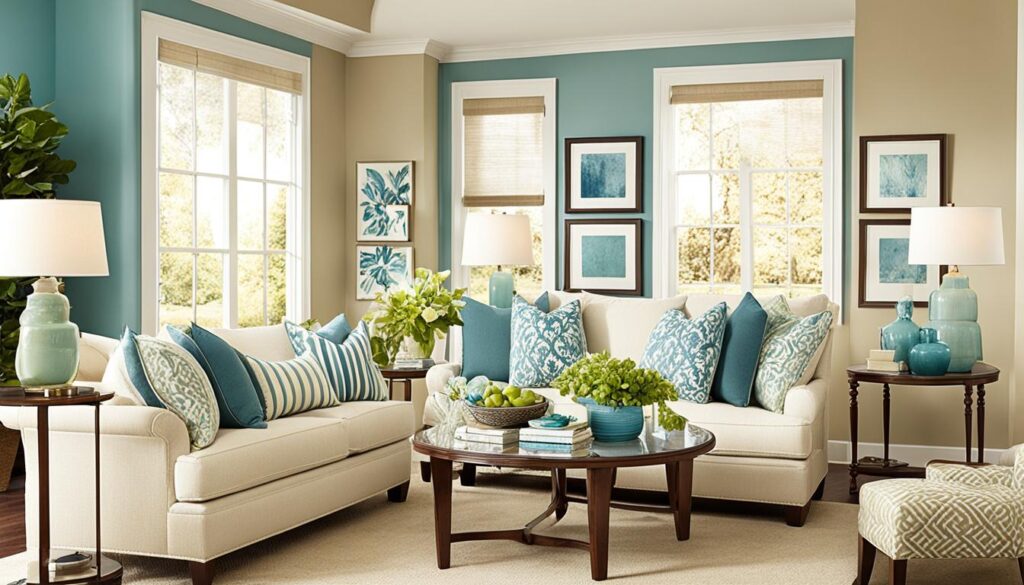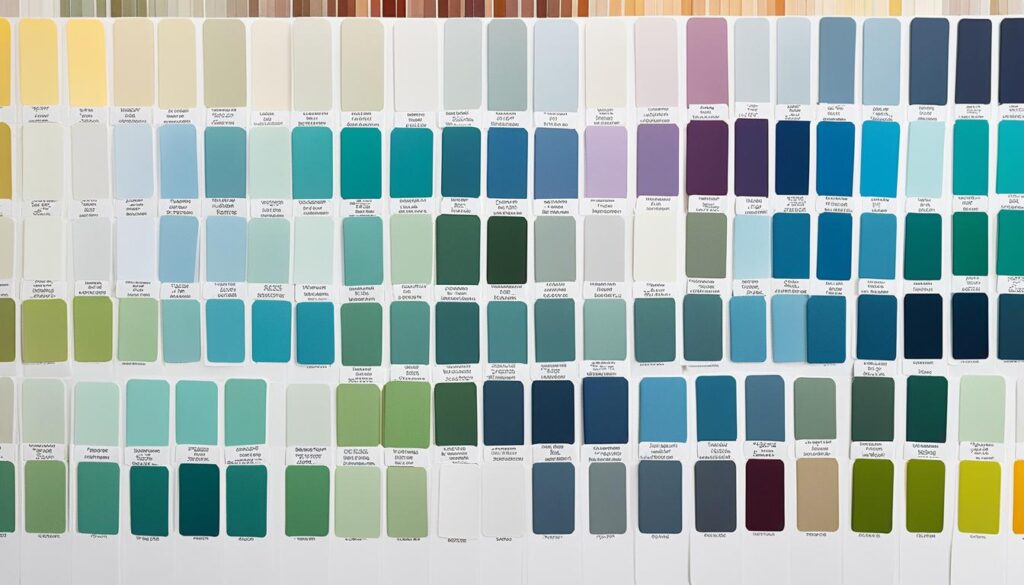How To Choose The Perfect Color Scheme For Your Home?
Choose The Perfect Color Scheme For Your Home : Choosing the right color palette for your interior design is key. It’s what many people wonder about. The colors you choose can make your space stand out. When changing a room’s look, picking a color scheme is often the first step.
It guides you in selecting the right furniture and setting the room’s atmosphere. This choice is like a golden thread. It helps maintain a unified look as you decorate.
Key Takeaways : The Perfect Color Scheme For Your Home
- Establishing a cohesive color palette can make your whole home feel welcoming.
- Look at what you have, like fixed finishes and furniture pieces, to start your design.
- A visual inspiration board helps to pick your favorite color schemes and patterns.
- Learning about color theory aids in making smart color scheme choices.
- Before painting, test color choices with swatches in various lighting conditions.
Understand the Importance of a Cohesive Color Palette
A good color palette is key for a welcoming home. It gives your space a unified look. This creates a smooth, flowing vibe from one room to the next.
Sets the Tone and Atmosphere for the Entire Home
The colors you pick can change how your home feels. With a main color and accents, you can set a theme. It can be calm and inviting or lively and fun.
Helps Maintain Consistency Throughout the Decorating Process
Choosing a unified color scheme ties your home together. It makes your choices easy and keeps everything looking great. This makes shopping for decorations and picking colors fun and simple.
Assess Your Existing Elements and Fixed Finishes

Starting a home color makeover means checking what’s already there. You should look at the existing elements and fixed finishes first. These are parts like your flooring, tiles, cabinets, and fireplaces. You need to see how to blend them in, not cover them up.
Identify Permanent Features You Want to Work With
First, go over your home’s fixed finishes and permanent features. Look at your floor, whether it’s hardwood, tile, or something else. Check out the cabinets too. Find what you want to keep and use in your new color choices.
Evaluate Furniture Pieces You Plan to Keep
Also, think about the furniture pieces you’re keeping. These items can help you choose colors. They can make your space look all together and serene.
Take Inspiration from Your Surroundings
Look around and see what colors catch your eye at home. Notice the hues and tones around you. They’ll be great hints for your color plan.
So, by looking carefully at your existing elements and fixed finishes, you can build a perfect color mix. It will blend well with your home’s layout and key parts. This way, your design will be united and beautiful.
Create a Visual Inspiration Board

Creating a visual inspiration board is an awesome way to work out your favorite color palette. Kick things off by pinning images on a site like Pinterest. These images should reflect the look you want for your space. You’ll start to see which colors you really like.
Pin Images That Speak to Your Desired Aesthetic
Start by pinning images that show the vibe you desire. This can be anything from a cozy farmhouse to a modern style or a natural, earthy theme. Look closely at the color schemes in these images. They give hints about your color preferences.
Identify Recurring Color Patterns and Preferences
As you add more to your visual inspiration board, you’ll notice certain color patterns. Some color combinations will stand out to you. Keep an eye on these. They’re a great start for choosing the colors in your home. Think about how different hues and tones can work together well.
| Key Takeaways | Benefits |
|---|---|
| Create a visual inspiration board on a platform like Pinterest | Helps you identify your desired aesthetic and color preferences |
| Pay attention to recurring color patterns and color combinations | Provides a solid foundation for developing your home’s color palette |
| Observe how hues and tones work together | Ensures a cohesive and harmonious look throughout your home |
Understand Color Theory and Color Relationships

Learning about color theory is key to picking the right home decor. It means knowing how colors relate. This includes warm and cool colors and color schemes like monochromatic, complementary, and analogous.
Warm vs. Cool Colors
Warm colors give off energy, with reds, oranges, and yellows. In contrast, cool colors calm the mind with blues, greens, and purples. A mix of these can balance your space beautifully.
Monochromatic Color Schemes
A monochromatic scheme sticks to variations of one color. It’s great for spaces wanting a modern, easy feel. It focuses on one color but brings depth with its various shades and tones.
Complementary Color Schemes
Complementary colors are opposites on the color wheel, like red and green. Mixing them pops visually. But matching their hue saturation is key to avoid chaos.
Analogous Color Schemes
In an analogous scheme, you pick 3 colors next to each other, like blue, blue-green, and green. This makes a soothing, connected space. It’s all about a smooth, natural blend.
Triadic Color Schemes
A triadic scheme uses colors evenly spaced on the color wheel, say red, yellow, and blue. It’s lively, so use it with care. It should be well-balanced to prevent overwhelming your room.
Choose The Perfect Color Scheme For Your Home

Start by thinking about the desired mood and atmosphere you want to set. Do you need a calm place or a lively one? Also, considering your home’s fixed finishes and existing elements is key.
Determine Your Desired Mood and Atmosphere
Think about the mood you desire at home. Do you want it to be peaceful or fun? Your choice of colors can bring the mood you’re after.
Consider Fixed Finishes and Existing Elements
Remember to look at what’s already there when picking colors. Your home’s fixed items like floors and furniture matter. Use these existing pieces to inspire your color choices.
Utilize Color Theory to Guide Your Choices
Learning about color theory can make choosing colors easier. Know how warm and cool colors work together. This knowledge helps in using colors that look good side by side.
Test Your Color Choices with Large Swatches

Once you’ve picked a few color options, you need to see them in the rooms. Use large swatches to test your colors in the actual space. This shows how they look with the room’s specific lighting.
Evaluate Colors in Different Lighting Conditions
Lighting really changes how colors look on your walls. So, check your color picks in all kinds of lighting. See how they do in both natural light and artificial light. This gives you a full picture of the color’s effect during the day and night.
Consider Natural and Artificial Light Sources
Observe how your color choices interact with the room’s lighting. The room’s lighting totally changes the color’s look. So, it’s crucial to see the swatches in the room’s natural light and artificial light.
Incorporate Accent Colors and Textures

Adding accent colors and textures goes a long way in enhancing your home’s look. Using fabrics, rugs, and accessories with pops of color changes everything. They make a space feel exciting and complete.
Use Fabrics, Rugs, and Accessories for Pops of Color
Textiles and fabrics bring in color accents and textures. Choose items like throw pillows or curtains with bold patterns. They help keep things balanced and interesting. Rugs are also key, linking all the colors together. Then, don’t forget about decorative accessories. Items like vases or lamps add those needed pops of color.
Bring in Natural Elements Like Flowers and Plants
Adding natural elements is a top tip for your home design. Flowers and plants bring in both color and texture. They can make any room feel fresh and full of life. By placing plants or flowers in different spots, you can strengthen your color palette. This makes your place more welcoming and tied together.
Achieve Cohesion in Open Floor Plans

Keeping a consistent color theme is harder in open floor plans. Yet, there are tricks to make everything look together well. By using smart design choices, you can create a beautiful, cohesive space.
Use Architecture to Guide Color Transitions
Your home’s design can show you where colors should change. Look for natural places to stop and start colors, like doorways. Let these architectural features guide how colors move from room to room.
Define Spaces with Rugs and Accent Walls
Rugs and accent walls are your friends in an open space. They can help carve out different areas, making each part feel unique. Plus, they keep your color plan looking smooth and tied together.
Employ Monochromatic Schemes or Three-Color Palettes
For open floor plans, less can be more when it comes to colors. Stick to a single shade or a small family of colors. It keeps the whole area feeling fluid and connected.
Embrace the Psychology and Impact of Color

Choosing colors for your home is essential. The psychology and impact of color can shape how you feel and perceive a space. Each hue can impact your emotion, the look of a room, and the general vibe.
Colors Can Influence Mood and Perception of Space
The psychology of color is key in how we feel in different places. Specific colors can trigger certain emotions and change how we see space. Knowing this helps pick the right color scheme for your living space.
Lighter Colors Can Make a Room Feel Larger
Choosing lighter colors can make a room seem bigger. Lighter shades bounce more light, creating an open, spacious feel. They give rooms a fresh, airy look.
Darker Colors Can Create a Cozier Atmosphere
On the other hand, darker colors can turn a space into a cozy nest. They bring warmth and intimacy. Deeper tones are ideal for areas meant for a snug or tranquil feel.
Also Read : Brighten Up: Best Outdoor Lighting Ideas Revealed
Conclusion
Finding the perfect colors for your home is a detailed process. It involves what mood you want, the furniture’s colors, and how light changes things. A good color plan will make your home feel welcoming and balanced. It will set the atmosphere and make everything work together wall color.
To choose the best colors, look at what you already have. Make a board with your favorite looks. Learn a bit about how colors work together. This will help you pick colors that show your style and create the vibe you want.
Think about adding some extra colors and textures. They can make your design stand out. If you have an open space, think about how colors will flow from one area to the next. This can pull your whole look together.
FAQs
Q: How do I choose the perfect color scheme for my home?
A: When choosing a color scheme for your home, consider how you want each room to feel. Think about whether you want a cohesive look throughout the house or different color palettes for each room.
Q: What should I consider when choosing a color palette for my home?
A: Consider factors such as the natural light in each room, the size of the space, and the existing furniture and decor. Choosing a neutral base color can help create a harmonious flow throughout the home.
Q: Is it better to stick to one color or use multiple colors in a color scheme?
A: It depends on the look you want to achieve. Using one dominant color with variations of that color can create a cohesive and calming feel. Incorporating two or three colors can add depth and visual interest to the space.
Q: How can I create a whole house color palette?
A: Start by choosing a base neutral color that will serve as the foundation for your color scheme. Then choose accent colors that complement each other and the neutral base to create a cohesive look throughout the house.
Q: Should I consult an interior designer when selecting a color palette for my home?
A: Consulting with an interior designer can be beneficial, especially if you are unsure about color choices or want professional advice on creating a cohesive color scheme that suits your style and preferences.
Q: What role does white paint play in a color palette for a home?
A: White paint can serve as a versatile and timeless choice for walls, trim, and ceilings. It can help brighten a space, make other colors pop, and create a clean and fresh backdrop for your decor.
Q: How do I ensure that colors flow well from one room to another in my home?
A: To create a seamless flow of colors in your home, consider using a consistent color palette and incorporating elements of one color in different shades or variations throughout the house.
